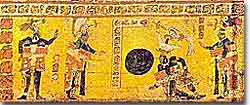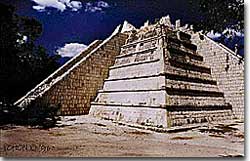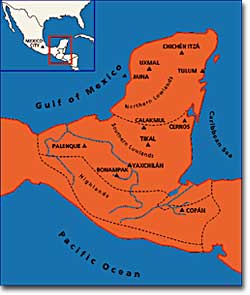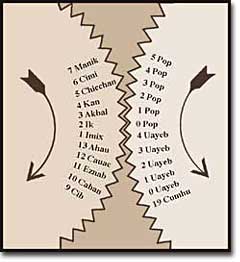11a. Blood of Kings: The World of the Maya

One day in the final century B.C.E., the people of Cerros made a momentous decision. Cerros was a tiny settlement at the edge of Chetumal Bay in what is now Belize. Its inhabitants were traders, fishermen, and farmers. Two thousand years ago, they decided to become a kingdom.
They demolished houses, smashed pottery and other possessions, scattering flowers over them. Amid the ruins they built a brand new city — a sparkling ceremonial center with pyramids, plazas, temples, ornamented stairways and ball courts, presided over by a king and royal court. On the temple terrace they mounted snarling masks of the Jaguar Sun God.
Cerros did not last long. But other great Maya cities soon flourished all across the Yucatan Peninsula. For 700 years — from 200 to 900 A.D. — a mighty civilization generated great art, as well as the most brilliant architecture, astronomy, and mathematics the Americas had ever seen.

Maya? Mayan? Mayas?
Ethnographers and linguists agree that "Maya" is the best translation from the Spanish and Maya languages, and can be used as either a noun or an adjective.
For example: "Ritual sacrifice was a part of Maya religion." and "Maya temples are masterpieces of ancient architecture."
There's just one exception to the rule. When discussing more than one Maya, use the plural form "Mayas," as in: "There were five Mayas on each team."
We now return you to your regularly scheduled program, already in progress.

At approximately 120,000 square miles, the lands of the Maya during the classic period (200-900 C.E.) covered nearly the entire Yucatán peninsula.
The Maya were a collection of people clustered in city-states. What united them was an idea. For the Maya the world of ordinary living and the Otherworld populated by gods, ancestors, and monstrous things, were equally real. There existed three regions, intricately bound together: the heavens, the earth, and the waters of the Underworld.
At particular places, the power to influence the Otherworld was concentrated. Here the Maya built temples and "mystic mountains" or pyramids at Tikal, Uaxactun, Palenque, Calukmul, Caracol, and Chitzen Itza. At each the Tree of Life sprouted, its roots buried in the dreaded Underworld, its leaves reaching to the gods. Blood of kings or captives provided the sap. In rites performed atop pyramids — those at Tikal reach over 250 feet into the sky — kings spilled their own blood, dragging stingray spines through their tongues to cement their relationship with the powers above. War captives were strapped to altars, their hearts torn from their breasts and offered up as sacrifices.

The Maya calendar consisted of two intersecting spoked wheels, the Haab or astronomical year, and the Tzolkin, a 260-day cycle that helped priests know the appropriate times for farming and religious ceremonies.
Even their leisure activities had religious implications. In U-shaped arenas with sloping wall, the Maya played ball. These, too, were religious rites. The ball — one foot across and made of solid rubber — apparently could not be handled. Murals show players wearing protective head- and waistbands, bouncing the ball with bodies and feet across the court. This was no mere sport, but ritualized battle. Losers stood to forfeit more than the lucrative contracts of today's athletes. Often they were destined for the sacrificial altar.
It's About Time
Time obsessed the Maya. They recorded the cycles of Venus, which repeats its 'wanderings' across the heavens every 584 days. They measured the length of the solar year to 365.242000 days, very close to the true value of 365.242198 days. This they called the Vague Year.
Alongside ran their Sacred Round of 260 days — 13 months of 20 days each. Their solar year consisted of 18 of these months, totaling 360 days. The five days remaining were considered times of extreme bad luck.
Most modern math uses the base 10 decimal system, one digit for each finger and thumb. The Maya used a base 20, employing both fingers and toes. Unial, the word for their 20-day month, is derived from unic, which meant "human being." To measure longer time periods, Maya mathematicians invented the Long Count, which they expressed as a series of five numbers. For example, 13.0.0.0.0 represented August 13, 3114 B.C. This was 'zero day,' when, they believed, the world began.
Your Average Maya
Such matters preoccupied the kings, scribes, and noble elite. But what of the ordinary people? What manner of lives did they lead? They lived in oval-shaped houses thatched with palm leaves — an efficient design that served to keep out both torrential rain and the summer heat. They farmed the land, raising crops of corn, beans, tomatoes and squash. Dog, deer, rabbit, and hot peppers rounded out their diet.
By the time the first European explorers arrived in the 1500s, Maya civilization had largely run its course. Most major sites had vanished, reclaimed by the forest's enveloping arms. Why? Historians can only speculate. But the story of Copan may hold one answer.
By 700 A.D., Copan was entering its greatest period of political and artistic expansion. Building proceeded at such a great pace that precious farmland was consumed. Farmers were forced to grow crops in terraced fields on the surrounding hills. Copan's king conquered nearby Quirigua and installed a Copan lord there. This lord turned on his king and launched a rebellion.
On May 3, 738 A.D., the Copan king was captured in battle and sacrificed at Quirigua. Copan never recovered. The building of monuments soon ceased. The land was so ravaged that only in the 20th century — 1300 years later — have population levels grown back to their former levels.
Too much destruction, too much neglect of the environment, and too much blood.







